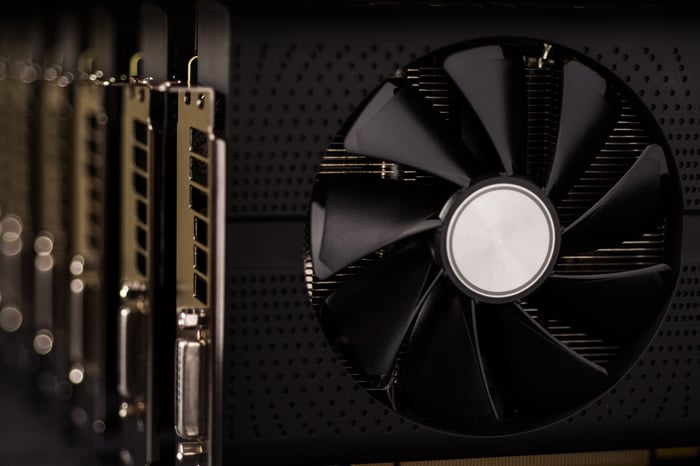Over the past three decades, Wall Street has seen its fair share of next-big-thing investments come and go. These include the rise of the internet, business-to-business commerce, genomics, 3D printing, cannabis, blockchain technology, cloud computing, and the metaverse. The next mammoth investment opportunity that has Wall Street drooling with anticipation is artificial intelligence (AI).
Put simply, AI describes the use of software and systems to handle tasks that humans would normally oversee. The key is machine learning, which allows software and systems to "learn" over time and become more efficient at their tasks. Machine learning gives AI broad application across most sectors and industries.

Image source: Getty Images.
According to a somewhat recent report from PwC, artificial intelligence is a "$15.7 trillion game-changer." PwC believes AI can have a $15.7 trillion global economic impact by 2030, with $9.1 trillion derived from increased consumption and $6.6 trillion coming from increased productivity.
Wall Street analysts aren't oblivious to the trillion-dollar potential AI brings to the table. Based on the price targets set by select analysts and pundits, two widely held high-flying AI stocks are expected to soar to trillion-dollar valuations.
Tesla: Projected market cap of $6.34 trillion by 2027
Among the dozens of brand-name companies that have tried to latch on to the AI wave, it's electric-vehicle (EV) manufacturer Tesla (TSLA 2.90%) that has received the loftiest price target on Wall Street.
For those curious, Tesla's AI ties come from its use of Level 2 full self-driving (FSD) software and AI-driven FSD chips, which are designed for partly autonomous driving. Level 2 autonomy requires a driver to be ready to take over at any time.
According to Ark Investment's founder and CEO, Cathie Wood, the largest automaker in the world can hit -- I hope you're sitting down for this -- $2,000 per share by 2027. This implies 935% upside to Tesla's share price over the coming four years and a jump from its current $612 billion market cap to $6.34 trillion. To put this another way, Wood believes Tesla's valuation will be more than double what Apple is currently worth by the end of 2027.
Wood's Monte Carlo valuation model makes a number of bold claims, which include Tesla producing between 10.3 million and 20.7 million EVs by 2027, and autonomous ride-hailing revenue for Tesla robo-taxis coming in at $613 billion four years from now. Unfortunately, even with Tesla being profitable and most new and legacy EV producers bleeding red, Wood's price target is nothing short of nonsense.
One of the prevailing investment theses for Tesla is the idea that it will expand production of its Model 3 sedan and Model Y SUV and allow manufacturing efficiencies to drive down the production costs of its EVs. In doing so, it will continue to grab share from new and legacy automakers and cement its place as an industry-changer. But that's not what we're seeing.
Although Tesla has had no trouble picking up share due to its first-mover advantages, its pricing strategy is showing cracks in the company's foundation. According to CEO Elon Musk during the recent quarterly conference call, demand is what has fueled a half-dozen price cuts in the United States since 2023 began. These price cuts come on the heels of historically high inventory levels. In other words, it would appear that competition and cyclical pressure are catching up with Tesla.
Something else to understand about Tesla is that it has been unable to meaningfully expand beyond selling and leasing EVs. Though it does have solar-panel installation, servicing, and its supercharger network, these are low-margin segments working against the company's bottom line. Growth and profits are, for the moment, entirely dependent on selling EVs -- and that part of its business looks to be weakening.
Cathie Wood and Ark Invest's price target is also highly unlikely to be reached because of Musk. Tesla's visionary CEO has turned into a notable liability. Many of the promises he has made on coming innovations have been delayed or simply never gotten off the ground, and he has drawn the ire of securities regulators on more than one occasion.
While Tesla could have an intriguing future, $2,000 by 2027 -- and even $193 per share as of this writing -- can't be justified.

Image source: Getty Images.
Nvidia: Projected market cap of $1.48 trillion
The second artificial intelligence stock that at least one Wall Street analyst sees soaring to a trillion-dollar valuation is Nvidia (NVDA 2.69%).
Analyst Hans Mosesmann of Rosenblatt maintained his buy rating on Nvidia following last week's earnings report, but nearly doubled his price target to $600 from $320. That target would assign the company a valuation of almost $1.5 trillion. For context, Nvidia had a market cap of less than $270 billion for a brief period in October 2022. It closed out this past week at $963 billion.
Most people are familiar with Nvidia because of its graphics processing units (GPUs) used by hard-core gaming enthusiasts. But it's not this gaming segment or its cryptocurrency ties that have the company's shares flying higher.
Instead, it has everything to do with the company's AI-driven A100 and H100 GPUs, which are being used in data centers. These exceptionally advanced and high-powered chips are the infrastructure backbone that allows AI software and systems to make split-second decisions and quickly process data and information.
Demand for anything having to do with AI is incredibly robust for Nvidia. Whereas Wall Street was expecting the company to guide to approximately $7.2 billion in total sales for the fiscal second quarter, management offered revenue guidance of $11 billion. CEO Jensen Huang noted the company was substantially increasing its supply of data-center products to meet this influx of demand.
However, we've seen this game-changing pivot from Nvidia before. It was first going to revolutionize gaming, and then it pulled forward plenty of sales during the euphoria surrounding cryptocurrency mining. AI simply represents the next evolution of demand for its business.
The point being that every one of these instances where demand was pulled forward by a next-big-thing investment proved unsustainable beyond a couple of quarters. To be clear, I'm not raining on the AI parade. Rather, I'm pointing out that actual demand for next-big-thing trends always fails to live up to outsize expectations from Wall Street analysts and investors. Chances are that Nvidia will face some very difficult year-over-year comparisons in fiscal 2025.
And gaming continues to be somewhat of a sore spot for the company. While sales did rebound to their highest level in a year during the fiscal first quarter ($2.24 billion), GPU demand in gaming is still down considerably with the worst of the pandemic in the rearview mirror.
Yes, data center demand is the new core growth driver. But when it comes to operating margin, Nvidia is taking a tangible hit as long as gaming revenue remains weak on a year-over-year basis.
Although Nvidia showed last week that betting against pricey companies can be a bad idea, it's a struggle to see how it will maintain its existing valuation, let alone add another $500 billion in market value.





